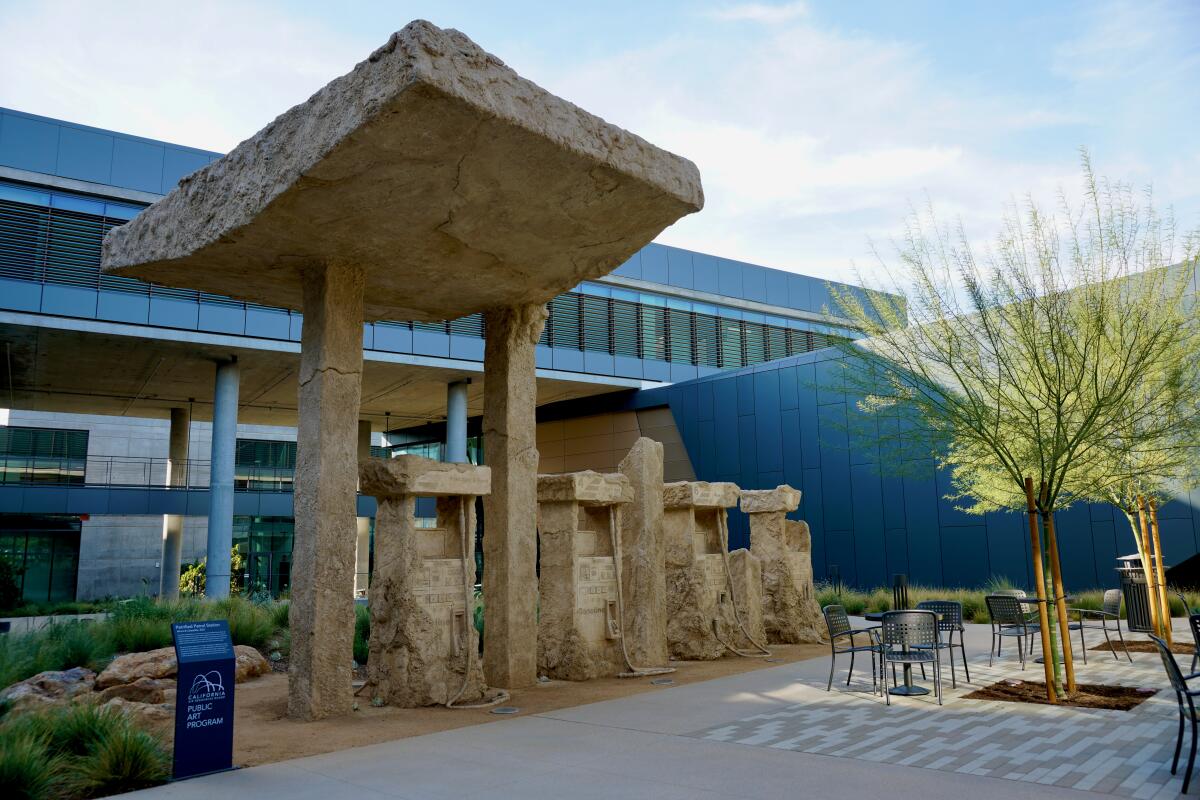Editorial: Why a fossilized gas station is the perfect symbol for California’s climate fight

When officials gathered to dedicate California’s new vehicle emissions testing and research facility in Riverside last week, their backdrop was a limestone sculpture of a fossilized gas station.
California is full of contradictions when it comes to the move away from fossil fuels. We’re a climate leader and we have the nation’s worst air pollution. We want to end sales of new gas-powered cars, yet we won’t stop drilling for oil.
But the state Air Resources Board’s decision to make a row of petrified gas pumps a centerpiece of its new $419-million facility in the smoggy Inland Empire? The symbolism is perfect.
It leaves no doubt about the next step in California’s decades-long war on smog: the elimination of fossil fuels that dirty the air and heat the planet.
It would be easy to poke fun at state officials for commissioning the $450,000 sculpture by Jennifer Allora and Guillermo Calzadilla and using enormous scissors to cut a gas pump hose instead of a ribbon. Where else but California would people so confidently project the death of the oil industry, at a time when gas prices have reached an all-time high?
But we should welcome California’s leaders’ unequivocal message about what our future must look like. Preventing a disastrous heating of the planet and easing the health damage in long-polluted communities absolutely require leaving fossil fuels in the rearview mirror and forcing the internal combustion engine into obsolescence. It’s suggesting otherwise that is dangerous and laughable at this point.
More important than the new building’s public art is the work that will go on inside. The campus, which is replacing a nearly 50-year-old facility in El Monte, includes space to test the engines and emissions from passenger cars, motorcycles, lawn and garden equipment, and the largest heavy-duty trucks and buses, as well as a state-of-the-art chemistry lab. It was funded, in part, with fines Volkswagen paid in connection with the 2015 diesel emissions cheating scandal that the state’s vehicle testing experts helped uncover.
It’s significant that the facility will be in Riverside, a place that “has always been the epicenter of the battle against smog,” said Mary Nichols, the former longtime Air Resources Board chair for whom the campus is named.
In recent years, the Inland Empire has seen long-term air quality gains undermined by rising temperatures from climate change and an explosion in warehouse development and diesel trucks. And air quality regulators have been criticized for doing too little to protect those who need it most, including communities of color that are exposed to higher levels of pollution. Maybe this new outpost, close to a major, truck-clogged freeway in an area that has had more than 150 bad air days this year, will inspire them to do better.
Still, I couldn’t help notice that one of the dedication ceremony’s sponsors was Southern California Gas Co., which has pushed to keep fossil fuels in our homes and communities as long as possible and is responsible for the largest methane gas leak in U.S. history.
Stanley Young, an Air Resources Board spokesman, told me that sponsorships by the gas company and other donors were limited to $5,000 and that “we see each of the sponsors as having a role in the effort to reduce emissions of greenhouse gases and the transition away from petroleum.”
It goes to show that California’s road to a low-carbon future will be bumpy, at times hypocritical, and will often fall short of its lofty rhetoric. But you’ve still got to appreciate the clarity of vision that sees fossil fueling stations becoming, well, fossils.
More to Read
A cure for the common opinion
Get thought-provoking perspectives with our weekly newsletter.
You may occasionally receive promotional content from the Los Angeles Times.











